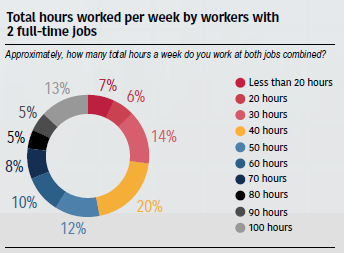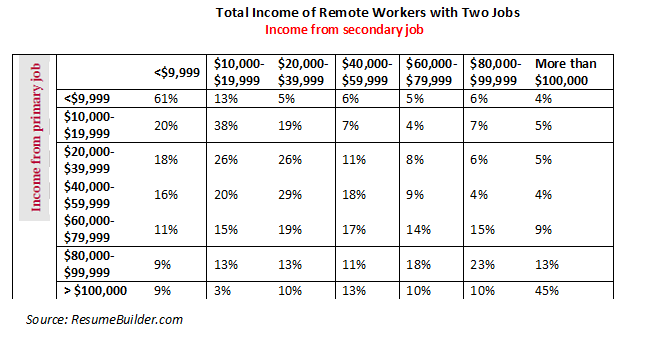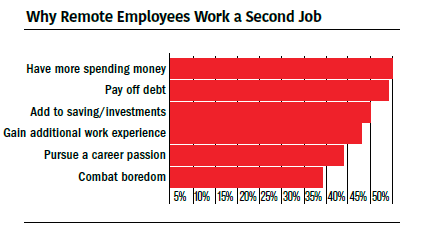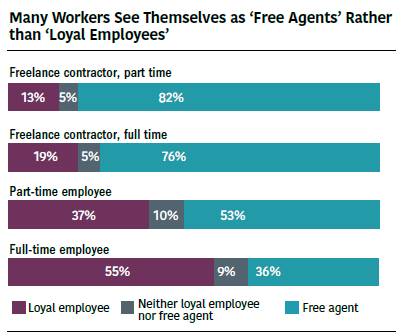It’s easy to understand why a primary appeal of remote working to employees is time and scheduling flexibility. Just from grooming less each morning and not commuting back and forth to the office, at-home workers can take back as much as two hours of “free time” per working day.
In the early months of the pandemic, several surveys suggested that workers were using this “added time” to do many of the things they always said they’d do if they had more time, such as exercising more, getting outdoors and spending more time with loved ones. As folks settle into the increased flexibility and reduced oversight of remote and hybrid work life, a large percentage of employees seem to be using their acquired “free time,” somewhat surprisingly, to work more. In an interesting turn of events, findings suggest that the side hustles, or what used to be called moonlighting, is becoming an aspect of the remote work new normal.
According to an October survey by ResumeBuilder.com of 1,250 full-time remote workers in the U.S., a full 69 percent claim to work a second side gig in addition to their full-time jobs. Make no mistake, this is not a matter of remote workers picking up a few hours of income here and there or doing delivery drives on weekends. Rather, more than half of these double-employed workers, and 37 percent of all remote-work respondents, have a second full-time job. In most cases, the second job also is remote. For about a third, their second job is in-person, and just less than a quarter of these respondents have a hybrid second full-time job.
For a full 84 percent of respondents who have two full-time jobs, their second job is “their own business.” According to career counselor and job search coach Stacie Haller, working a full-time job while starting a small business on the side provides a safety net during the early, unpredictable days of building a company.

Source: ResumeBuilder.com
“The time is ripe for those who want to start their own business but can’t afford to leave their current job in order to do so,” she said. “Remote work and flexible hours make it easier to start a business on the side, and grow it to a full-time operation, by providing a steady income stream.”
This approach was how Christine Wang, founder of TheSkiGirl, an online resource for skiing enthusiasts, was able to get her website off the ground.
“When I was first building a client base, I still needed a steady income,” Wang says. “Keeping my regular job while working freelance on the side required effort, motivation and focus, but it allowed me the time to grow my business.”
That’s not to suggests respondents who say they are working two full-time jobs necessarily are working 80 hours a week, or the equivalent of two 40-hour-a-week jobs. In fact, about one in four employees working two full-time remote jobs said they are able to do so because neither job requires 40 hours per week to maintain. Indeed, among those working two full-time jobs, just less than a quarter report working 80 hours or more total per week. Three in 10 work 50 to 70 total hours per week between two jobs, while the plurality of respondents in this group (47 percent) clock 40 hours or less at both jobs combined each week.
“Among workers whose second full-time job is in-person, 60 percent double-dip by completing remote work while at an in-person job,” said the ResumeBuilder report. “Thirty-two percent maintain separate work schedules, squeezing in remote work when not at their in-person gig.”
Despite the number of hours worked, employees working multiple jobs believe there is no negative impact on their productivity. Indeed, the overwhelming majority of people who are working multiple jobs say the practice either makes them more productive (49 percent) or equally as productive (39 percent) as working a single job. What’s more, 61 percent of workers with two full-time jobs say all that hustling makes them more productive, while 31 percent claim to be equally as productive as when they worked only one job.

Of course, people aren’t always the best judge of their own productivity, but the responses seem to suggest that while employers are just beginning the transition from measuring employee productivity by output instead of hours worked, remote workers already are operating under that assumption.
Breaking down responses by income level, a remote worker’s secondary job, more often than not, is at the same level of pay as their primary job. One might assume that an employee with, say, a six-figure salary would not have the time and capacity to work a second six-figure-salary job, but among remote workers with two jobs whose primary job earns them $100,000 or more a year, 45 percent are paid $100,000 or more annually in their secondary job. Likewise, those who earn between $80,000 and $99,999 in their primary job are most likely to have a secondary job that earns a similar amount.
The primary motivation for working multiple jobs, as might be expected, is money, according to respondents, of which 50 percent said the primary reason was “more spending money.” Likewise, 49 percent of moonlighters cited “paying off debt,” while 45 percent were looking to add to savings or investments. Almost as important are the opportunities to gain additional work experience or pursue a career passion, named by 43 percent and 39 percent of respondents, respectively.

Source: ResumeBuilder.com
In terms of the demographics of remote workers with a side hustle, ResumeBuilder found some divergence between genders and ages. Men are nearly twice as likely as women to work a second full-time job, by a rate of 45 percent to 27 percent.
For men, the number one reason they are working two jobs is to have more spending money (53 percet), while women are most keen on using their second job to pay off debt (49 percent). Eighty-two percent of responding men, and 70 percent of responding women are running their businesses as their second job.
Men and women said they feel the impact of working two jobs differently. Fifty-five percent of male respondents say having a second job makes them more productive, compared to 40 percent of women. Conversely, women are more than twice as likely as men to say working two jobs makes them less productive (18 percent compared to 7 percent).
Breaking things down by age, workers between 35 and 44 years of age are most likely to have a side hustle (73 percent) and are most likely to own a business as their second job (85 percent). A similar number of workers aged between 25 and 34 years (71 percent) and 18 to 24 years (68 percent) also are holding two jobs, while 74 percent of 25- to 34-year-olds are running their own businesses as a second job.
Americans aged 55 years and older are least likely to work two jobs, although more than half (55 percent) of them do.
Across most age groups, the plurality of respondents has a remote position as their second job. However, Gen Zers are the only age group more likely to have an in-person job as their side gig.

Source: MIT Sloan Management Review; Deloitte
Perhaps in the end, it’s not so surprising that remote employees are taking advantage of their new-found freedom to work elsewhere. According to a study by MIT Sloan Management and Deloitte, a substantial percentage of surveyed workers consider themselves to be a “free agent” rather than a “loyal employee.” That include more than half of part-time workers and more than a third of full-time employees.









